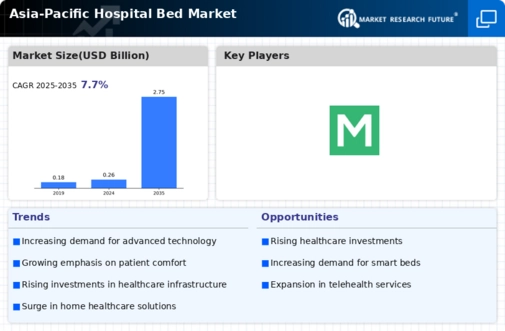Asia Pacific Hospital Bed Size
Asia Pacific Hospital Bed Market Growth Projections and Opportunities
The Asia Pacific Hospital Bed market is significantly influenced by the region's expanding healthcare infrastructure. Countries in the Asia Pacific are investing heavily in building and upgrading hospitals, which directly impacts the demand for hospital beds. The process of aging among residents in the Asia Pacific region is an arena of great influence. While the existing aging population increases in number, so does the problem of chronic diseases and aging-related ailments and a simultaneous surge in demand for specialized medical care that will resolve with hospital beds that are specially designed for elderly people. Governments and healthcare allowed an impact to the main features of the hospital bed market. Through the cadres in the form of subsidies, grants or regulatory frameworks, either governments across the Asia-Pacific regions accelerate, or impede market growth, depending on the type of these policy. The usage of cutting-edge technology on health grounds is entirely changing the look of hospital beds. Characteristics such as electronic controls, smart monitoring systems, patients data integration, and so on have become a trend, which has impacted the preferences of healthcare providers for these products in the Aisa-Pacific region. Asia Pacific countries act as medical tourism centers, with India Thailand, and Singapore being companies leading in the attraction of people seeking medical care from any part of the world. The increasing rate of inpatient treatment seakers stimulates the expansion of the required high technology hospitals, which should be equipped with the latest medical beds, contributing to the market's steadiness. It is true that the inflation of the economy in the Asia Pacific has corresponded with the greater amount of disposable income. Consequently, higher purchasing power enables individual consumers and health dependent facilities to spend on better quality, and technologically advanced hospital beds that in turn, drives the market to expand. With the dramatic upsurge in prevalence of chronic diseases in the Asia Pacific, considerable weight is put on the healthcare systems. The beds filled to help the electrical mounting of the chronic diseases have seen high demand for adjustable beds and those with air-relieving features. Attributes of the Asia Pacific region such as cultural peculiarities and diversity of healthcare are determining the types of hospital beds that are in high demand. For instance, a wide-range selection of beds may be desirable with specific designs, features, and functionalities, conditioned by cultural and traditional medical practices in different regions.
Collaborations between healthcare institutions, manufacturers, and technology providers are becoming increasingly common. Such partnerships drive innovation and the development of customized solutions, impacting the dynamics of the hospital bed market in the Asia Pacific. The hospital bed market is also affected by supply chain dynamics, including the availability of raw materials and manufacturing capabilities. Disruptions in the supply chain, whether due to geopolitical factors or unforeseen events like the COVID-19 pandemic, can have a significant impact on market trends and pricing.





Leave a Comment